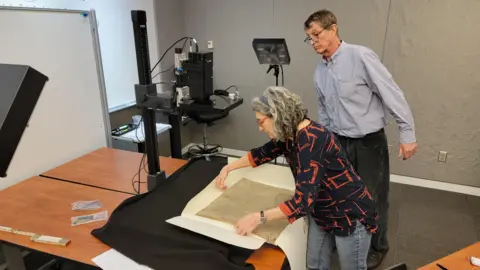A manuscript once considered an unofficial copy of Magna Carta is now believed to be a genuine version and ”one of the world’s most valuable documents”, according to UK academics.
Harvard Law School paid $27.50 (then about £7) for it in 1946 and for years it has remained tucked away in its library, its true identity unknown.
But two medieval history professors have concluded it is an extraordinarily rare and lost original Magna Carta from 1300, in the reign of King Edward I, that could be worth millions.
”This is a fantastic discovery,” said Prof David Carpenter from King’s College London, who began analysing it after seeing digitised images of it on the US university’s website.
“It is the last Magna Carta… [and it] deserves celebration, not as some mere copy, stained and faded, but as an original of one of the most significant documents in world constitutional history; a cornerstone of freedoms past, present and yet to be won.”
He said he was “absolutely astonished” that not only had he discovered this authentic version, but that, over the years, no-one seemed to know what they had and that it had been sold “for peanuts”.
According to Harvard’s library accession register, the document catalogued as HLS MS 172 was acquired in 1946 and was described in an auction catalogue as a “copy made in 1327… somewhat rubbed and damp-stained”.
The manuscript’s purchase price of $27.50 would be about $450 (£339) in 2025, based on inflation.
 Nicholas Vincent/UEA
Nicholas Vincent/UEAMagna Carta is a charter first issued by King John in 1215 that guaranteed the liberties and rights of his subjects and also placed the Crown under the authority of the law.
Considered a key step in the evolution of human rights against oppressive rulers, it has influenced the framing of constitutions around the world.
The document – which was circulated across the counties of England – was reissued after 1215 by successive kings through the years to 1300, meaning “there may have been 200 originals”, said Prof Nicholas Vincent of the University of East Anglia, Norwich, who helped Prof Carpenter establish the Harvard document’s authenticity and provenance.
Today, 25 of these originals survive from the various editions between 1215 and 1300, most of which are in the UK.
Two are held in Washington DC’s National Archives, and one in Parliament House in Canberra, Australia.
 King’s College London
King’s College London“It is an icon both of the Western political tradition and of constitutional law,” said Prof Vincent.
”If you asked anybody what the most famous single document in the history of the world is, they would probably name Magna Carta.”
 MB Toth/RB Toth Associates
MB Toth/RB Toth AssociatesThe professors, who spent a year researching Harvard’s document, believe it is from the town of Appleby, Cumbria.
They think the trail from Appleby to Harvard involves the Lowthers, a land-owning family who gave the document to Thomas Clarkson, a leading abolitionist of the 1780s.